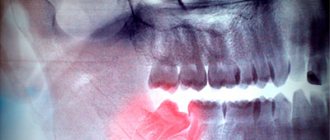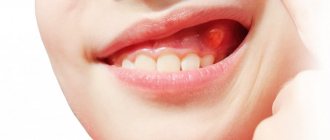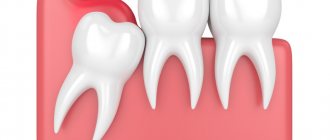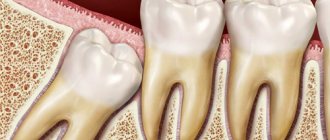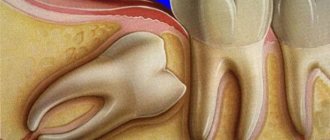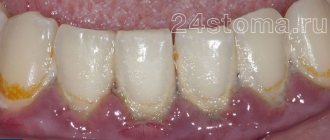From this article you will learn:
- the gums around the wisdom tooth are inflamed: what to do,
- wisdom tooth: hood and its removal (price for 2022),
- how to relieve inflammation.
The article was written by a dental surgeon with more than 19 years of experience.
Difficulty in the eruption of wisdom teeth is often accompanied by the development of inflammation of the gums around them. The mucous membrane of the gums, which partially covers the crown of the erupting wisdom tooth, is called the wisdom tooth hood (Fig. 1-3).
Because The hood over the wisdom tooth is not tightly adjacent to the crown of the tooth - a semi-closed space is formed between them, in which favorable conditions are created for the proliferation of pathogenic bacteria and the development of inflammation. In dentistry, an inflamed hood on a wisdom tooth is usually called “pericoronitis.”
What is complex wisdom tooth extraction?
Tooth extraction is called complex if the tooth has several roots, and the operation will require an incision into the soft tissue of the gums and, possibly, the periosteum. Another difference from classic removal is the need to use additional tools (except for forceps and an elevator). The difficulty of performing surgical intervention is due to the difficulty of accessing the extreme elements of the dentition, the root features of the “eights” and the specifics of the clinical case (they are often dystopic or impacted).
Important: you cannot postpone the removal of the defective “eight”. This can lead to suppuration and, as a consequence, to the formation of an abscess and the development of sepsis.
Treatment
Sick teeth need to be treated, the sooner the better. The dentist’s task is to save the tooth, but if measures are not taken in time, it will have to be removed to avoid serious consequences.
Methods:
- Remineralization Applications of calcium and fluoride preparations and electrophoresis help restore enamel at the initial stage.
- Filling the cavity The affected tissues are removed, their place is filled with filling material.
- Partial prosthetics A crown is placed on the tooth, which protects it from mechanical and biological influences. The crown is placed on a previously depulped, dead tooth.
- Removal If the pulp is affected and the inflammatory process threatens to develop into an abscess, the tooth is pulled out. You should not resist the removal of rotten teeth - they do nothing but harm.
It is easier to prevent any process than to take a long time to eliminate the consequences. By following simple preventive measures and regularly visiting the doctor, you can avoid tooth decay and maintain your smile and self-confidence for many years.
Indications and contraindications for surgery
Indications
Surgery is necessary if the wisdom tooth:
- Dystopic (the direction of growth is changed towards adjacent teeth, tongue or cheek)
- Impacted (not fully or not fully erupted)
- Has roots that are too long (this may initiate their penetration into the maxillary sinus or fusion with the jaw)
- Caused inflammation of the “hood” of the gums or periodontal tissue (pericoronitis)
- Caused the formation of a follicular cyst, phlegmon, gumboil or fistula
- Destroyed due to the development of caries or other dental disease
- Caused inflammation of the trigeminal nerve
- Became a source of permanent injury to the oral mucosa
- Interferes with the eruption of other molars with a narrow jaw
Absolute contraindications:
- Malignant tumor in the root zone
- Hemangioma (benign formation)
- Serious chronic cardiovascular problems
Relative (temporary) prohibitions:
- Infectious diseases, including those of the oral mucosa
- Having had a heart attack or stroke
- Taking anticoagulants
- Exacerbation of psychoneurological diseases
- Pregnancy and breastfeeding (except for emergency indications)
Removing the "hood"
Often, difficult eruption of a wisdom tooth leads to inflammation of the gums that cover it (“hood”). This causes enlargement of the lymph nodes, increased temperature, pain when chewing, injury to the gums and, as a result, rapid proliferation of pathogenic bacteria, leading to inevitable suppuration. This situation occurs quite often and is an indication for excision of gum tissue. If the “eight” under the hood is viable and does not cause inconvenience, then it is not removed.
Types of anesthesia
Performing surgical interventions is impossible without high-quality anesthesia. During extractions, the following types of anesthesia can be used:
- infiltration anesthesia – provides a local effect. Injected with a syringe into the gum or intraosseously. This is the most common option for dental procedures;
- conductive - has a more powerful effect and is used when operating on particularly complex cases. The injection is carried out to the branches of the trigeminal nerve;
- intraligamentary - used to anesthetize one tooth. The medicine is injected with a syringe into the ligament that holds the tooth in the alveolus.
Expert opinion: Some patients want dental surgery to be performed under general anesthesia. But this type of anesthesia is not as harmless as it is described in advertising articles. It has been proven that it negatively affects the patient's health. An operation to remove teeth, even such complex ones as the “eight”, is not a direct indication for the use of general anesthesia (with rare exceptions). Surgery is painless with the correct selection of local anesthetic. Therefore, you should not strive for general anesthesia and put unnecessary drug burden on the body.
How to care for a hole
Immediately after the procedure, you can apply ice to your cheek to relieve pain and swelling. For severe pain, you can take an analgesic. During the healing period, follow these simple rules:
- Do not rinse your mouth with any solutions unless prescribed by your dentist.
- The tooth socket should not be touched with hands or a toothbrush.
- Avoid physical activity and do not go to the sauna until the wound is completely healed.
- Take medications prescribed by a specialist.
- Do not drink alcohol, as it can cause bleeding.
The surgeon will give you detailed recommendations after the operation. If you notice symptoms of complications, contact your dentist immediately. At our clinic, please contact the doctor on duty for help.
Complications after wisdom tooth removal can occur almost immediately after the operation. Some of them are natural, since removal is a complex surgical procedure, “eights” are located in hard-to-reach places, and they have large roots. But sometimes complications can make themselves felt within six months, and they provoke diseases of the gums, adjacent teeth, bones and even joints. To prevent such problems, you need to know the first signs of pathology and urgently contact an experienced dentist.
Instruments used during surgery
When performing complex extractions, the surgeon may need the following instruments:
- forceps – for extracting a tooth or its elements if they can be grasped. There are different shapes: straight, curved, S-shaped;
- elevator - for loosening entire dental units or their roots in the alveolus;
- excavator - for removing fragments from a deep root fracture;
- scalpel - for cutting soft tissues;
- drill or chisel - for sawing (splitting) large elements of the root or coronal parts with a very dense bone structure.
Stages of surgery
The G8 extraction protocol implies a strict sequence of certain stages:
- diagnosis of the clinical situation. It is carried out by the surgeon when the patient comes for an appointment. First, the doctor conducts a visual examination, determining the extent of damage to the tooth and surrounding tissues. Next - mandatory radiography for an objective assessment of the current condition. The image allows you to clarify the details of the clinical case: the number of roots, possible interweaving, angle of inclination. If necessary, the examination is supplemented by orthopantomography (obtaining an image in 3D format);
- determination of the type of anesthetic and its dose. Questioning the patient about the presence of allergic reactions to any medications;
- injection of an anesthetic drug into the surgical area. The mechanism of action of the anesthetic is as follows: the substance acts on the nerve, it stops transmitting impulses to the brain. As a result, after 5 to 10 minutes a person stops feeling pain in the place where the medicine was injected. After some time (up to 6 hours), it stops working, the transmission of nerve impulses is restored;
- the operation itself. Typically lasts from 30 minutes to one and a half hours. Complex removal involves cutting the gums with a scalpel and stitching them together upon completion of surgical procedures. An incision into the gum tissue allows the surgeon to reach the root system. Then the doctor, using a drill and/or chisel, saws (splits) the molar into several parts and takes it out in separate pieces. If necessary, the roots are taken out in the same way. After all parts are removed, the hole is treated with an antiseptic, and the incision is sutured with surgical threads;
- At this point the operation ends, the surgeon gives the patient recommendations on oral care.
Note: extraction can only be performed by a qualified dental surgeon in a medical institution in compliance with aseptic and antiseptic standards.
Stages of decay development
There is no acute form of caries, so small changes are difficult to notice, they accumulate - and now a person cannot smile, only stumps of teeth remain. Therefore, it is important to undergo preventive examinations regularly. The dentist can identify the problem at the initial stage and can easily fix it.
- Rotting begins at the spot stage. The color of part of the surface changes. Enamel demineralization begins. At this stage, treatment is quick and easy.
- The superficial process of demineralization is increasing, but the pain syndrome has not yet manifested itself. The tooth can react to sweet, sour, cold, hot.
- Middle stage The lesion reaches the enamel-dentin junction. Painful sensations occur periodically. Large areas are affected.
- Deep damage The decay process affects the dentin surrounding the pulp. If this process is left unattended, pulpitis will develop. And this is far from the only problem.
Possible complications
Successfully performed surgery and following the doctor’s recommendations minimize the risk of complications. But they are still possible. This:
- severe pain that continues for several days;
- heavy bleeding from the surgical wound;
- inflammatory process (characterized by swelling of the gums, cheeks, and a significant increase in temperature);
- osteomyelitis of the jaw;
- loss of sensitivity in some areas of the face (parasthesia). Possible if the facial nerve is damaged.
Attention! All of the above symptoms are a good reason to immediately consult a doctor. Waiting “for it to resolve on its own” is unacceptable; this can lead to serious consequences, including sepsis.
Causes of rotting
In the first place is fear. It is the irrational fear of the dentist, which is difficult to control, that makes us put off visiting the doctor. Often to the point where it is no longer possible to save the tooth. No matter what facts they give us, no matter how much we persuade ourselves, phobias do not lend themselves to rational arguments.
But this is far from the only reason.
General diseases
Our body is a single system. Discord in one place leads to problems in another. Thus, diseases of the gastrointestinal tract cause dental problems.
Infections, fungal diseases, even hormonal imbalances often lead to inflammatory processes in the mouth.
Ecological problems
In regions where drinking water is of poor quality, dental problems are 3-4 times more common. The same picture is observed where there are large industrial enterprises. Increased amounts of toxic microelements in the environment harm overall health and negatively affect teeth.
Diet
There are foods that provoke the growth of bacteria in the oral cavity, which means they contribute to tooth decay. Yes, that same sugar, but not only that. Acids formed during the fermentation of carbohydrates are the main enemies of enamel.
Lifestyle
Addictions of any kind are not good for dental health. Cigarettes, drugs, alcohol are a direct path to problems.
This also includes restrictive diets. Vegetarians, vegans, and Keto fans need to carefully ensure that the body receives all trace elements and vitamins.
Oral diseases
Inflammatory processes in the mouth are a haven for bacteria. Therefore, it is important to regularly carry out sanitation and ultrasonic cleaning of teeth. Periodontal disease, periodontitis, stomatitis, gingevitis, cheilitis require special treatment, which is better not to delay.
Oral hygiene
This is perhaps the easiest way to destroy teeth. All that’s left to do is brush and floss twice a day. 90% of the population does this, but not as carefully as we would like. There are special teeth cleaning schemes. They involve treating surfaces from all sides and for a certain time. Unfortunately, now
90% are those who brush their teeth for less than 1 minute.
Genetic predisposition
Alas, often all preventive measures are not able to help keep teeth safe and sound. Healthy, strong teeth, just like bad ones, are inherited.
